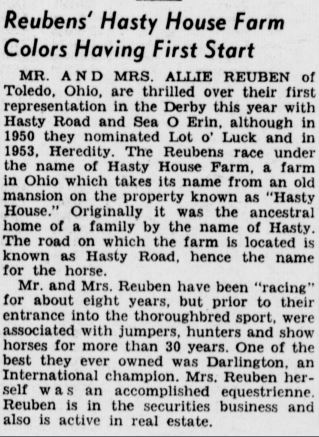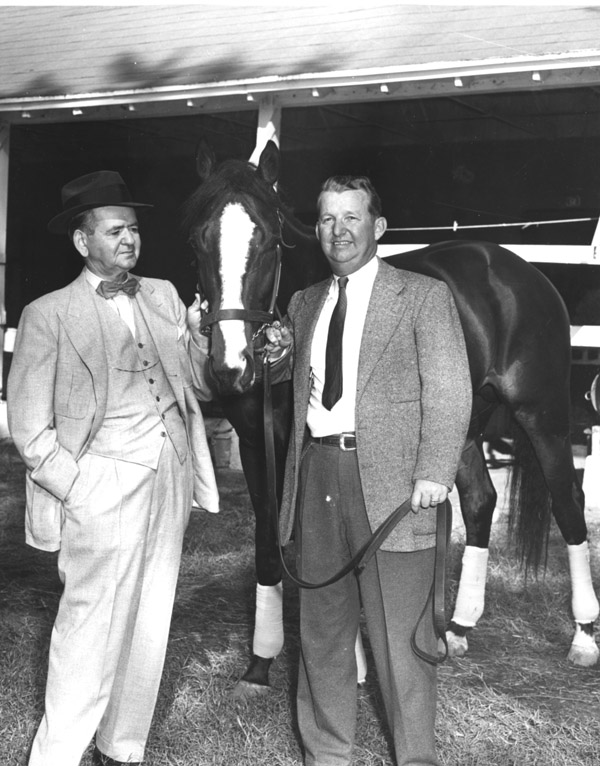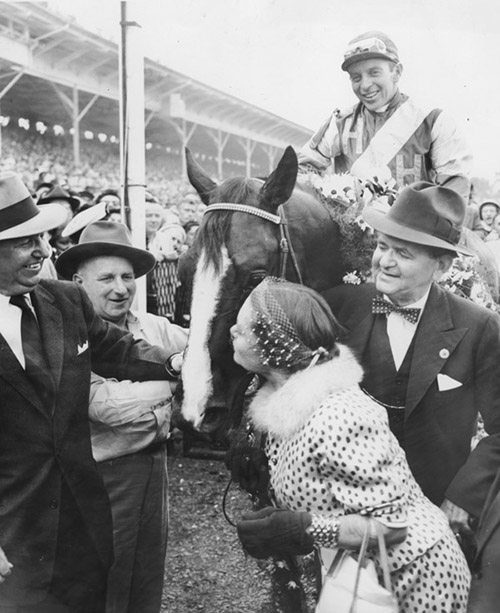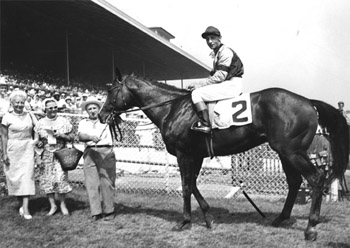Toledo had a horse in the Kentucky Derby?
The year was 1954, and in fact, Toledo had not one but two horses in the Run for the Roses that year (Goyamo, who finished fourth, was the other). The most well-known of the two came from a thoroughbred farm out along…well, when I tell you the name of the horse, you’ll probably figure it out: Hasty Road (photo at top, from a 1953 Arlington Park race), from Hasty House Farm.
Yes, that Hasty Road, the one that runs off Central Ave. east of Reynolds Rd. and the former Toledo, Angola & Western railroad tracks (now the University Park Trail).

Hasty House Farm was owned by Allie Reuben, president and treasurer of the Al E. Reuben Co., a real estate firm he founded in 1912. His firm was involved in many major property transactions, including the sale of Swayne Field to Kroger and land acquisition for Toledo Express Airport, according to his obituary (Reuben died in 1975 at the age of 82).
(That said, in a writeup about Swayne Field on the Society for American Baseball Research’s website, author John Husman (author of Baseball in Toledo) writes that Reuben actually owned Swayne Field from 1933 (when its owners went bankrupt) until its sale to Kroger to build the present-day shopping center. Also, this Sports Illustrated article from 1959 said Reuben was once the owner of the Mud Hens and gave Casey Stengel his first managerial job as manager of the Mud Hens.)
But it was as owner of Hasty House Farm, a 60-acre plot in Sylvania Township (now Ottawa Hills), that Mr. Reuben achieved national prominence, parlaying a two-horse purchase in the late 1940s into a stable that by 1954 surpassed the big boys in terms of earnings.

The Sports Illustrated article says that Reuben came into racing aftrer World War II and had moderate success with yearlings purchased at sales at Saratoga and Keeneland. “Then,” Reuben recounts, “we decided to buy ‘made’ horses on my handicapping; horses we thought we could improve. In 1949 we purchased Seaward and Inseparable from Brookmeade, and they won over $450,000, most of this in our colors.”
Reuben ran good horses in big races and won them; these were not the type of horses who ran at Fort Miami. Just looking at the winner’s circle photos in the Toledo-Lucas County Public Library’s Images in Time database, the photos are a who’s who of 1950s American racetracks – Arlington Park, Washington Park (in Chicago, gone), Hawthorne, Hialeah, Santa Anita – and a who’s who of famous jockeys like Eddie Arcaro and Willie Shoemaker, on horses like Oil Capitol, Sea O’ Erin, Queen Hopeful, Ruhe, Platan, and others like Alspal, Pomace and Hasty Doll.
Probably one of Hasty House Farms’ most famous horses was Hasty Road, an extremely successful two-year-old who, in 1954, ran in the Kentucky Derby and Preakness.

In the Derby, Hasty Road, a frontrunner, did so most of the way until Determine caught him in the stretch. Hasty Road, the 5-1 fourth betting choice, finished second. “Hasty Road began fast, bore to the outside in the run to the first turn, retained a clear lead until reaching the stretch, then was unable to withstand the winner,” according to the chart.
Ironically, Hasty Road had beaten Determine a week earlier in the Derby Trial Stakes. And, with Determine ineligible for the Preakness two weeks later, Hasty Road set off for Baltimore for the Preakness.
The Blade (and unfortunately, the Daily Racing Form) for that date is missing, but there were other newspapers in the world to cover it: Hasty Road won the Preakness. Hasty Road shot to the front and led all the way, winning by a neck over the favorite, Correlation. The winner’s share was $91,600.
Hasty Road was shipped to New York in anticipation of the Belmont Stakes, but after one workout over the track, Reuben decided not to run him. The Preakness was Hasty Road’s peak; he never had the same form after the race, won only one stakes race after that and was retired to stud as a 4-year-old. He died in 1978 at the age of 27.
Here’s a video of the 1954 Preakness:
As for the farm itself, it became the subdivision known as Hasty Hill Farms, a $40 million housing development built right across the street from Wildwood Preserve, which itself almost became a housing development. Half of the development came from the horse farm, the other half came from the estate of Edwin G. Marshall, a prominent Toledo attorney. The Reuben estate was on a farm first occupied in 1834 by Charles Hasty.

Glad to see you’re back. What a pleasant surprise. I had about given up but checked tonight on a whim and saw the new postings in 2020. Love the site.
This site is amazing! Literally, I love this!
I met Mrs. Rueben when I was on a flight from Atlanta to Chicago!